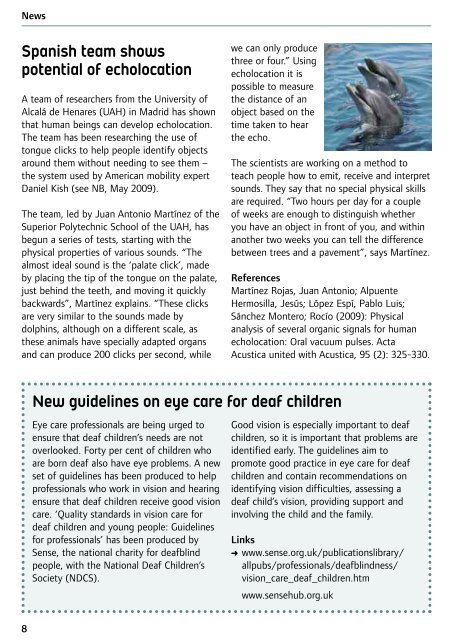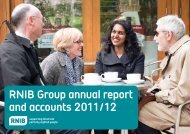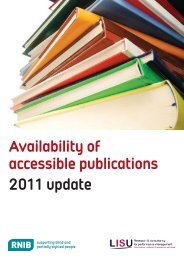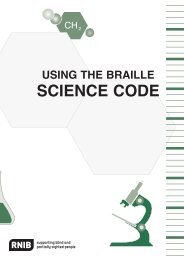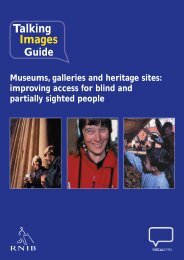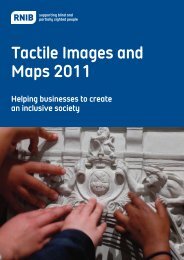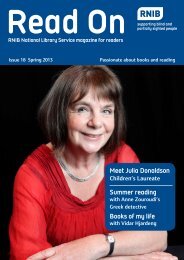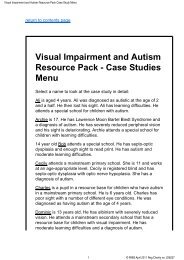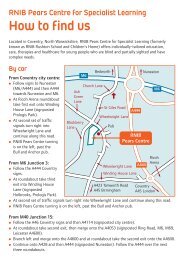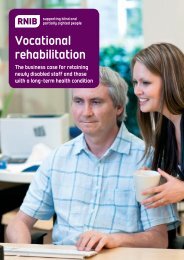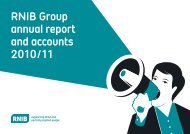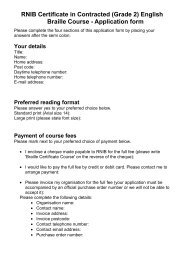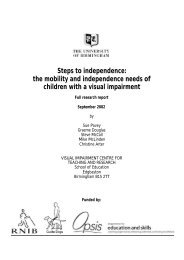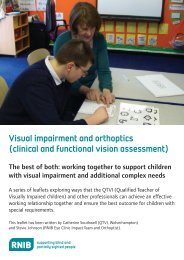Reflections on sight loss - RNIB
Reflections on sight loss - RNIB
Reflections on sight loss - RNIB
Create successful ePaper yourself
Turn your PDF publications into a flip-book with our unique Google optimized e-Paper software.
News<br />
Spanish team shows<br />
potential of echolocati<strong>on</strong><br />
A team of researchers from the University of<br />
Alcalá de Henares (UAH) in Madrid has shown<br />
that human beings can develop echolocati<strong>on</strong>.<br />
The team has been researching the use of<br />
t<strong>on</strong>gue clicks to help people identify objects<br />
around them without needing to see them –<br />
the system used by American mobility expert<br />
Daniel Kish (see NB, May 2009).<br />
The team, led by Juan Ant<strong>on</strong>io Martínez of the<br />
Superior Polytechnic School of the UAH, has<br />
begun a series of tests, starting with the<br />
physical properties of various sounds. “The<br />
almost ideal sound is the ‘palate click’, made<br />
by placing the tip of the t<strong>on</strong>gue <strong>on</strong> the palate,<br />
just behind the teeth, and moving it quickly<br />
backwards”, Martínez explains. “These clicks<br />
are very similar to the sounds made by<br />
dolphins, although <strong>on</strong> a different scale, as<br />
these animals have specially adapted organs<br />
and can produce 200 clicks per sec<strong>on</strong>d, while<br />
we can <strong>on</strong>ly produce<br />
three or four.” Using<br />
echolocati<strong>on</strong> it is<br />
possible to measure<br />
the distance of an<br />
object based <strong>on</strong> the<br />
time taken to hear<br />
the echo.<br />
The scientists are working <strong>on</strong> a method to<br />
teach people how to emit, receive and interpret<br />
sounds. They say that no special physical skills<br />
are required. “Two hours per day for a couple<br />
of weeks are enough to distinguish whether<br />
you have an object in fr<strong>on</strong>t of you, and within<br />
another two weeks you can tell the difference<br />
between trees and a pavement”, says Martínez.<br />
References<br />
Martínez Rojas, Juan Ant<strong>on</strong>io; Alpuente<br />
Hermosilla, Jesús; López Espí, Pablo Luis;<br />
Sánchez M<strong>on</strong>tero; Rocío (2009): Physical<br />
analysis of several organic signals for human<br />
echolocati<strong>on</strong>: Oral vacuum pulses. Acta<br />
Acustica united with Acustica, 95 (2): 325-330.<br />
New guidelines <strong>on</strong> eye care for deaf children<br />
Eye care professi<strong>on</strong>als are being urged to<br />
ensure that deaf children’s needs are not<br />
overlooked. Forty per cent of children who<br />
are born deaf also have eye problems. A new<br />
set of guidelines has been produced to help<br />
professi<strong>on</strong>als who work in visi<strong>on</strong> and hearing<br />
ensure that deaf children receive good visi<strong>on</strong><br />
care. ‘Quality standards in visi<strong>on</strong> care for<br />
deaf children and young people: Guidelines<br />
for professi<strong>on</strong>als’ has been produced by<br />
Sense, the nati<strong>on</strong>al charity for deafblind<br />
people, with the Nati<strong>on</strong>al Deaf Children’s<br />
Society (NDCS).<br />
Good visi<strong>on</strong> is especially important to deaf<br />
children, so it is important that problems are<br />
identified early. The guidelines aim to<br />
promote good practice in eye care for deaf<br />
children and c<strong>on</strong>tain recommendati<strong>on</strong>s <strong>on</strong><br />
identifying visi<strong>on</strong> difficulties, assessing a<br />
deaf child’s visi<strong>on</strong>, providing support and<br />
involving the child and the family.<br />
Links<br />
➜ www.sense.org.uk/publicati<strong>on</strong>slibrary/<br />
allpubs/professi<strong>on</strong>als/deafblindness/<br />
visi<strong>on</strong>_care_deaf_children.htm<br />
www.sensehub.org.uk<br />
8


